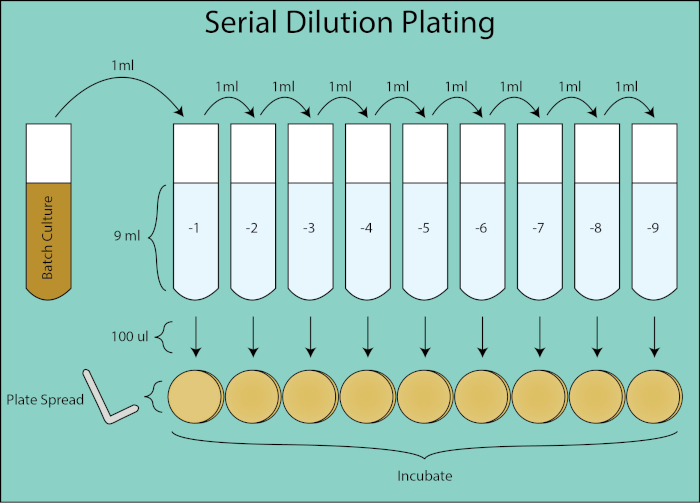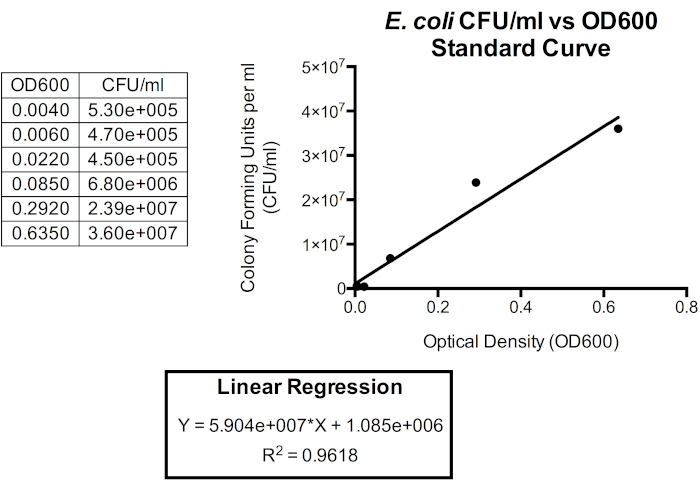Growth Curves: Generating Growth Curves Using Colony Forming Units and Optical Density Measurements
Source: Andrew J. Van Alst1, Rhiannon M. LeVeque1, Natalia Martin1, and Victor J. DiRita1
1 Department of Microbiology and Molecular Genetics, Michigan State University, East Lansing, Michigan, United States of America
Growth curves provide valuable information on bacterial growth kinetics and cell physiology. They allow us to determine how bacteria respond in variable growth conditions as well as to define optimal growth parameters for a given bacterium. An archetypal growth curve progresses through four stages of growth: lag, exponential, stationary, and death (1).

Figure 1: Bacterial growth curve. Bacteria grown in batch culture progress through four phases of growth: lag, exponential, stationary, and death. Lag phase is the period of time it takes for the bacteria to reach a physiological state capable of rapid cell growth and division. Exponential phase is the stage of fastest cell growth and division during which DNA replication, RNA transcription, and protein production all occur at a constant, rapid rate. Stationary phase is characterized by a slowing down and plateauing of bacterial growth due to nutrient limitation and/or toxic intermediate accumulation. Death phase is the stage during which cell lysis occurs as a result of severe nutrient limitation.
Lag phase is the period of time it takes for the bacteria to reach a physiological state capable of rapid cell growth and division. This lag occurs because it takes time for bacteria to adjust to their new environment. Once the necessary cellular components are generated in lag phase, bacteria enter the exponential phase of growth where DNA replication, RNA transcription, and protein production all occur at a constant, rapid rate (2). The rate of rapid cell growth and division during the exponential phase is calculated as the generation time, or doubling time, and is the fastest rate at which the bacteria can replicate under the given conditions (1). The doubling time can be used to compare different growth conditions to determine which is more favorable for bacterial growth. The exponential growth phase is the most reproducible growth condition as bacterial cell physiology is consistent throughout the entire population (3). Stationary phase follows the exponential phase where cell growth plateaus. Stationary phase is brought on due to nutrient depletion and/or accumulation of toxic intermediates. Bacterial cells continue to survive in this stage, although the rate of replication and cell division is drastically reduced. The final phase is death, where severe nutrient depletion leads to the lysing of cells. Features of the growth curve that provide the most information include the duration of lag phase, the doubling time, and the maximum cell density reached.
Quantification of bacteria in batch culture can be determined using both colony forming units and optical density measurements. Enumeration by colony forming units (CFU) provides a direct measurement of bacterial cell counts. The standard unit of measure for CFU is the number of culturable bacteria present per 1 mL of culture (CFU/mL) determined by serial dilution and spread plating techniques. For each timepoint, a 1:10 dilution series of the batch culture is performed and 100 µl of each dilution is spread plated using a cell spreader.

Figure 2. Serial dilution plating schematic. General flowthrough for dilution plating from batch culture. The batch culture is serially diluted 1:10 by transferring 1 mL of the previous dilution into the subsequent tube containing 9ml PBS. From each dilution tube, 100 µl is spread plated using a plate spreader which is an additional dilution of 1:10 as it is 1/10th the volume of 1 mL volume when calculating CFU/mL. Plates are incubated and enumerated once clonal colonies grow on the plates.
The plates are then incubated overnight and clonal colonies enumerated. The dilution plate which grew 30-300 colonies is used to calculate the CFU/mL for the given timepoint (4, 5). Stochastic variation in colony counts under 30 are subject to greater error in the calculation of CFU/mL and counting colonies greater than 300 can be underestimated due to colony crowding and overlapping. Using the dilution factor for the given plate, the CFU of the batch culture can be calculated for each timepoint.
Optical density gives an instant approximation of bacterial cell count measured using a spectrophotometer. The optical density is a measure of absorbance of light particles that pass through 1cm of culture and detected by a photodiode sensor (6). The optical density of a culture is measured in relation to a media blank and increases as bacterial density increases. For bacterial cells, a wavelength of 600 nm (OD600) is typically used when measuring optical density (4). By generating a standard curve relating colony forming units and optical density, the optical density measurement can be used to readily approximate the bacterial cell count of a batch culture. However, this relationship begins to deteriorate as early as 0.3 OD600 as cells begins to change shape and accumulate extracellular products in the media, influencing the optical density reading as it relates to CFU (7). This error becomes more pronounced during stationary and death phases.
Here, Escherichia coli is grown in Luria-Bertani (LB) broth at 37°C over the course of 30 hours (7). Both CFU/mL and optical density growth curves have been generated as well as the standard curve relating optical density to CFU.

Figure 3. Escherichia coli optical density at 600 nm wavelength (OD600) growth curve. Optical density values were taken directly from the spectrophotometer after blanking with sterile LB media. OD600 values greater than 1.0 were diluted 1:10 by combining 100 µl culture with 900 µl fresh LB, again measured, and then multiplied by 10 to obtain the OD600 value. This step is taken as the accuracy in measurement of the spectrophotometer is reduced at high cell density. From the curve, lag phase extends to around 1h of growth, transitions to exponential phase from 2h to 7h, then begins to plateau, entering stationary phase. Death phase is not a stark transition, however, as optical density gradually begins to decline after 15h.

Figure 4. Escherichia coli colony forming unit per milliliter (CFU/mL) growth curve. CFU/mL values for each timepoint were calculated from the dilution plate that contained 30-300 colonies. From the curve, lag phase extends out to around 2h of growth, transitions to exponential phase from 2h to 7h, then begins to plateau, entering stationary phase. Death phase is not a stark transition, however, as CFU/mL gradually begins to decline after 15h from a peak of 2 x 109 to approximately 5 x 108 at 30 hours.

Figure 5. Standardization curve for CFU/mL versus OD600. A linear regression can be used to relate these units so that optical density may be used to approximate bacterial cell density. Optical density can be used to provide and instant approximation of the CFU/mL of the batch culture. Here, only the first six timepoints are plotted as the relationship between OD600 and CFU/mL is less accurate beyond 1.0 OD600 as cell shape and extracellular products begin to accumulate as the bacteria enter stationary phase, which occurs shortly after reaching 1.0 OD600. Changes in cell shape and extracellular products in the media influence the optical density reading and therefore the relationship between optical density and the number of bacteria in the culture is also impacted.
The doubling time has also been determined to be 15 minutes and 19 seconds. From this data, the capacity for growth in LB for E. coli can be visualized and be used for comparison between different media or bacteria.
1. Set-up
- Required laboratory materials: liquid media, solidified agar media, Erlenmeyer flasks, 15 mL test tubes, phosphate buffered saline (PBS), bacterial cell spreader, 70% ethanol, and a spectrophotometer. All solutions and glassware must be sterilized prior to use.
- Prepare the work station by sterilizing with 70% ethanol. Work near a Bunsen burner to prevent contamination of media.
- When working with bacteria, proper personal protective equipment and aseptic technique
Plots of colony forming units and optical density are two ways to visualize growth kinetics. By determining the relationship between CFU/mL and OD600, the optical density plot also provides an estimate of CFU/mL over time. Conditions that result in the shortest doubling time are considered optimal for growth of the given bacteria.
Growth curves are valuable for understanding the growth kinetics and physiology of bacteria. They allow us to determine how bacteria respond in variable growth conditions as well as define the optimal growth parameters for a given bacterium. Colony forming unit and optical density plots both contain valuable information depicting the duration of lag phase, maximum cell density reached, and allowing for the calculation of bacterial doubling time. Growth curves also allow for comparison between different bacteria under the
- R. E. Buchanan. 1918. Life Phases in a Bacterial Culture. J Infect Dis 23:109-125.
- CAMPBELL A. 1957. Synchronization of cell division. Bacteriol Rev 21:263-72.
- Wang P, Robert L, Pelletier J, Dang WL, Taddei F, Wright A, Jun S. 2010. Robust growth of Escherichia coli. Curr Biol 20:1099-103.
- Goldman E, Green LH. 2015. Practical Handbook of Microbiology, Third Edition. CRC Press.
- Ben-David A, Davidson CE. 2014. Estimation method for serial dilution experiments. J Microbiol Methods 107:214-221.
- Koch AL. 1968. Theory of the angular dependence of light scattered by bacteria and similar-sized biological objects. J Theor Biol 18:133-156.
- Sezonov G, Joseleau-Petit D, D'Ari R. 2007. Escherichia coli physiology in Luria-Bertani broth. J Bacteriol 189:8746-9.
Skip to...
ABOUT JoVE
Copyright © 2024 MyJoVE Corporation. All rights reserved